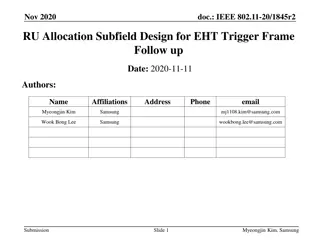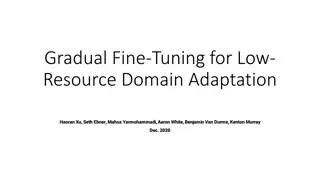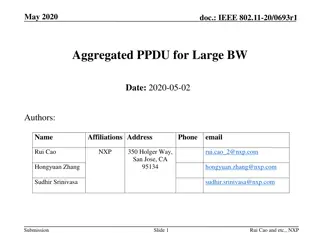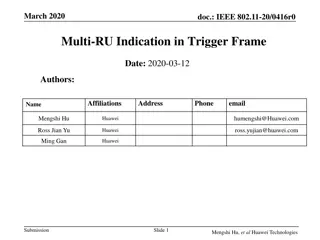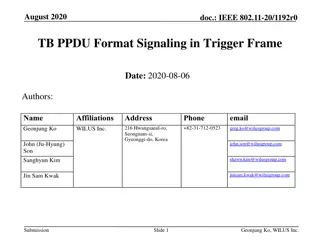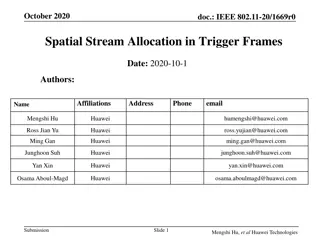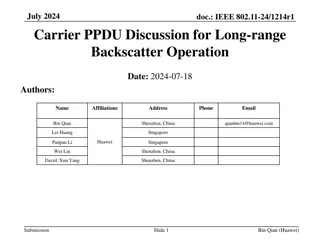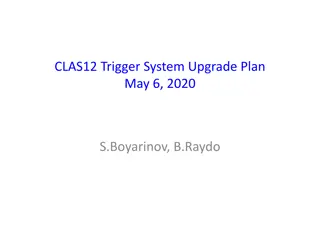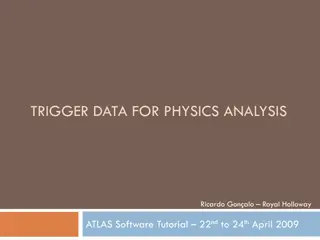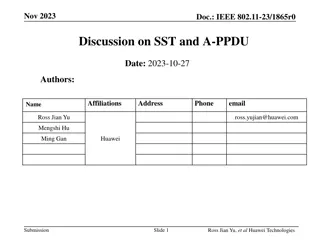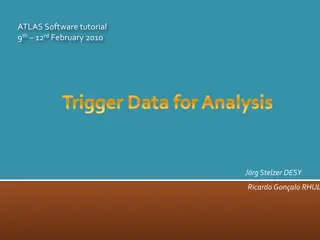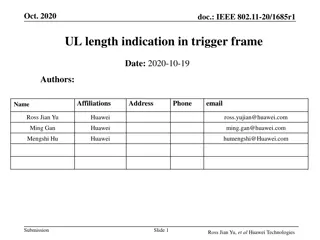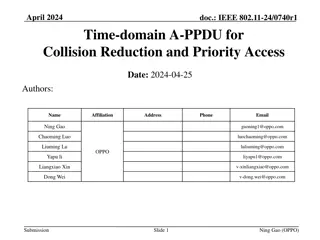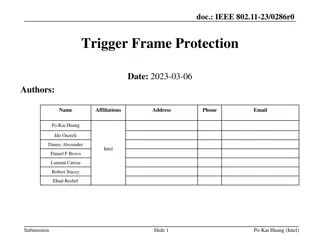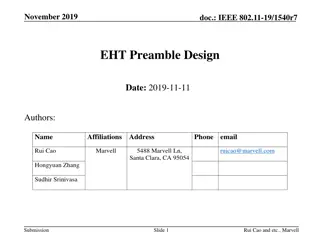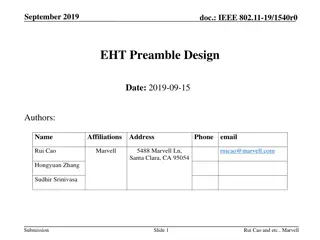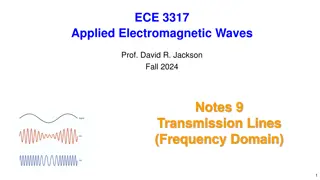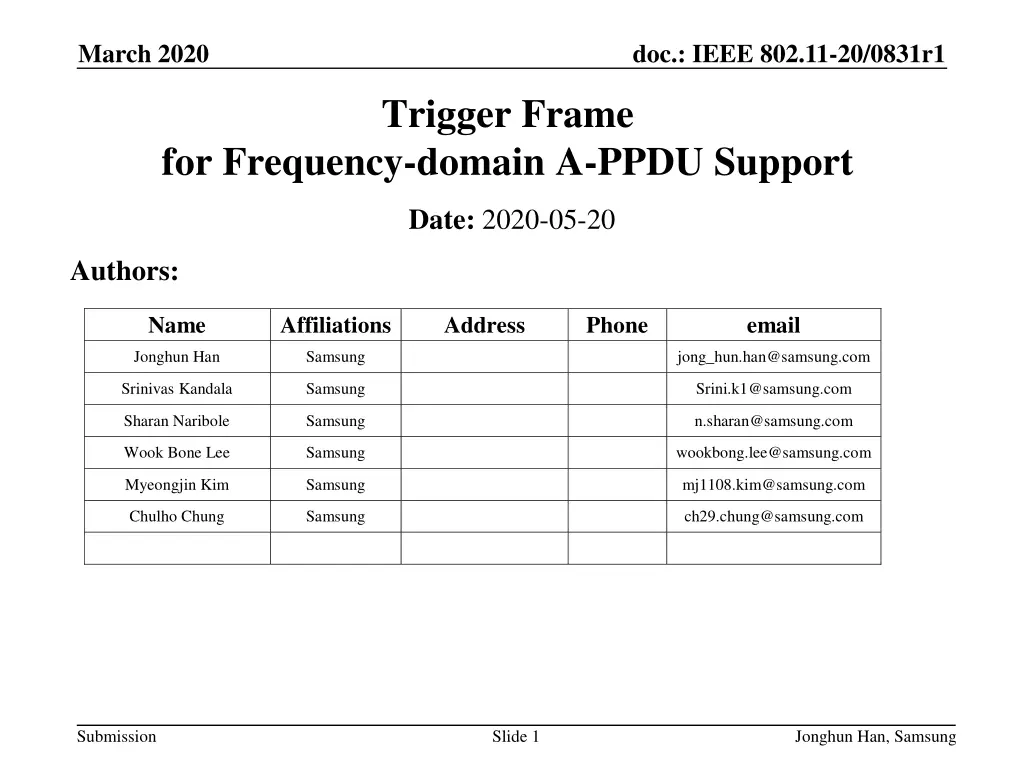
IEEE 802.11-20/0831r1 Trigger Frame for Frequency-domain A-PPDU Support
Explore the design options and requirements for the IEEE 802.11-20/0831r1 trigger frame supporting Frequency-domain A-PPDU in the March and May 2020 documents. Learn about expected UL operations, design principles, and options for supporting UL FD A-PPDUs for enhanced connectivity.
Uploaded on | 2 Views
Download Presentation

Please find below an Image/Link to download the presentation.
The content on the website is provided AS IS for your information and personal use only. It may not be sold, licensed, or shared on other websites without obtaining consent from the author. If you encounter any issues during the download, it is possible that the publisher has removed the file from their server.
You are allowed to download the files provided on this website for personal or commercial use, subject to the condition that they are used lawfully. All files are the property of their respective owners.
The content on the website is provided AS IS for your information and personal use only. It may not be sold, licensed, or shared on other websites without obtaining consent from the author.
E N D
Presentation Transcript
March 2020 doc.: IEEE 802.11-20/0831r1 Trigger Frame for Frequency-domain A-PPDU Support Date: 2020-05-20 Authors: Name Affiliations Address Phone email Jonghun Han Samsung jong_hun.han@samsung.com Srinivas Kandala Samsung Srini.k1@samsung.com Sharan Naribole Samsung n.sharan@samsung.com Wook Bone Lee Samsung wookbong.lee@samsung.com Myeongjin Kim Samsung mj1108.kim@samsung.com Chulho Chung Samsung ch29.chung@samsung.com Submission Slide 1 Jonghun Han, Samsung
March 2020 doc.: IEEE 802.11-20/0831r1 Background Frequency-domain (FD) A-PPDU will be supported in 11be We need a MAC protocol to support it Announcement/Trigger frame DCN 0674r3 [2] contribution provides MAC requirements to support A-PPDU [Downlink] enhanced downlink (DL) announcement frame [Uplink] enhanced uplink (UL) trigger frame In this contribution, we propose several design options for trigger frame to support FD A-PPDU Submission Slide 2 Jonghun Han, Samsung
March 2020 doc.: IEEE 802.11-20/0831r1 Expected UL Operation Trigger frame allocates the 80MHz segment(s) to be used for UL HE STA will be assigned to use P80 or P160 (backward compatibility) EHT and EHT+* STA will be assigned to use secondary segments * EHT+: the amendments after EHT Submission Slide 3 Jonghun Han, Samsung
May 2020 doc.: IEEE 802.11-20/0831r1 Design Principles for Trigger Frame MAC requirements New design should support any combination of HE, EHT and EHT+ PPDUs to support UL FD A-PPDUs New design should incorporate EHT and EHT+ specific fields E.g., UL BW extension, RU allocation, etc. Backward compatibility HE STA shall not be affected by the new design Forward compatibility New design should be easily extendable for EHT+ Submission Slide 4 Jonghun Han, Samsung
March 2020 doc.: IEEE 802.11-20/0831r1 Design Options for Trigger Frame [Option1] Aggregated-MPDU design Define EHT/EHT+ variant of the trigger frame To trigger HE, EHT and EHT+ STAs with one PPDU, AP should use the A-MPDU E.g., Trigger frame (for HE STA) and trigger frame variant(s) (for EHT and EHT+ STA) are aggregated [Option2] Single-MPDU design [Option 2a] Extend common/user info of the trigger frame by using reserved AID Assign specific AID(s) to indicate the common/user info fields for EHT and EHT+ STAs [Option 2b] Extend common/user info of the trigger frame by setting AID subfield to 4095 Use AID 4095 (Start of padding field) for HE STA(s) not to decode EHT/EHT+ information Submission Slide 5 Jonghun Han, Samsung
March 2020 doc.: IEEE 802.11-20/0831r1 Option 1: Aggregated-MPDU Design Operation example Submission Slide 6 Jonghun Han, Samsung
May 2020 doc.: IEEE 802.11-20/0831r1 Option 1: Aggregated-MPDU Design Trigger type subfield encoding Trigger type subfield is 4-bit in the trigger frame MSB of trigger type subfield is currently reserved Candidate options for indicating EHT and EHT+ variant [1-bit] Use MSB 1-bit as a EHT/EHT+ indication e.g., 0000: HE Basic, 1000: EHT/EHT+ Basic [1-subtype] Assign one subfield value. e.g., 8: EHT, 9:EHT+, 10-15: Reserved Slide 7 Submission Jonghun Han, Samsung
May 2020 doc.: IEEE 802.11-20/0831r1 Option 1: Aggregated-MPDU Design Common info field of EHT variant TF If trigger type is EHT Basic Trigger (subtype 8), then the rest of common info field can be re-defined to support EHT information E.g., UL BW field can be extended to support 320MHz We may include protocol subfield to indicate exact amendment instead of assigning separate trigger type value for each amendment after HE E.g., 00: EHT, 01:EHT+, Submission Slide 8 Jonghun Han, Samsung
May 2020 doc.: IEEE 802.11-20/0831r1 Option 1: Aggregated-MPDU Design User info field of EHT variant TF If trigger type is EHT Basic Trigger (subtype 8), then User info field can also be re-defined to support EHT user-specific information E.g., RU allocation can be extended to support multi-RU We may include protocol subfield to indicate exact amendment instead of assigning separate trigger type value for each amendment after HE E.g., 00: EHT, 01:EHT+, Submission Slide 9 Jonghun Han, Samsung
March 2020 doc.: IEEE 802.11-20/0831r1 Option 2a: Single-MPDU Design w/ Reserved AID Operation example Submission Slide 10 Jonghun Han, Samsung
May 2020 doc.: IEEE 802.11-20/0831r1 Option 2a: Single-MPDU Design w/ Reserved AID Common/user info field stays the same EHT or EHT+ STAs can obtain the common info field and additionally obtain EHT or EHT+ specific common info EHT or EHT+ specific common info Assign one of the reserved AID (2008-2044, 2047-4094) to indicate EHT or EHT+ common info Example of EHT common info field AID (2008) EHT UL BW Other EHT-specific parameters EHT STAs obtain EHT-specific common information from the user info field with AID 2008 while HE STAs ignore it Length of EHT common info should be the same with that of the user info field since this field reuses the existing user info field format (5-bytes) Instead of assigning separate AID for EHT and EHT+ common info, EHT common info field may include protocol subfield to indicate amendment Submission Slide 11 Jonghun Han, Samsung
May 2020 doc.: IEEE 802.11-20/0831r1 Option 2a: Single-MPDU Design w/ Reserved AID EHT or EHT+ specific user info Assign one of the reserved AID (2008-2044, 2047-4094) to EHT or EHT+ user info Example of EHT user info field 12-bit 12-bit 16-bit Other EHT user-specific parameters AID (2010) (EHT) AID RU allocation EHT STAs obtain EHT-specific user information from the user info field with AID 2010 while HE STAs ignore it Additional (EHT) AID field is required to specify EHT STA Length of EHT user info should be the same with that of the user info field since this field reuses the existing user info field format (5-bytes) Only 2-bytes are free to use per-user info field We may need to integrate multiple user info fields for the same (EHT) AID Instead of assigning separate AID for EHT and EHT+ user info, EHT user info field may include protocol subfield to indicate amendment Submission Slide 12 Jonghun Han, Samsung
March 2020 doc.: IEEE 802.11-20/0831r1 Option 2b: Single-MPDU Design w/ AID 4095 Operation example Submission Slide 13 Jonghun Han, Samsung
May 2020 doc.: IEEE 802.11-20/0831r1 Option 2b: Single-MPDU Design w/ AID 4095 Common/user info field stays the same The user info field with AID 4095 (Start of padding field) in 11ax Padding is optionally present to give the recipient STAs enough time to prepare a response [Proposal] EHT/EHT+ specific common info and user info will be followed by the user info field with AID 4095 HE STAs believe there are no meaningful information after AID 4095 EHT STAs will decode after the user info field with AID 4095, since all EHT or EHT+ specific information will be followed EHT or EHT+ specific common info and user info format can be re- designed with full flexibility The padding AID for EHT/EHT+ STAs should be additionally assigned Submission Slide 14 Jonghun Han, Samsung
May 2020 doc.: IEEE 802.11-20/0831r1 Pros and Cons of Candidates Summary table Candidates Pros Cons [Option 1] Aggregate-MPDU Simple just adding new trigger variants Cannot use non-HT duplicate format [Option 2a] Single-PPDU with the reserved AID Can use non-HT duplicate format Overhead of indicating EHT user info Can use non-HT duplicate format High design flexibility (no format limitation of EHT common/user info) [Option 2b] Single-PPDU with the AID 4095 New padding AID required for EHT and EHT+ STA(s) Submission Slide 15 Jonghun Han, Samsung
May 2020 doc.: IEEE 802.11-20/0831r1 Summary New trigger frame design options to support UL FD A-PPDU 1. Aggregate-PPDU approach 2. Single-PPDU approach a. Using the user info field with reserved AIDs b. Using the user info field with AID 4095 (Preferred) We investigate pros and cons of each option Submission Slide 16 Jonghun Han, Samsung
May 2020 doc.: IEEE 802.11-20/0831r1 Straw Poll Do you support in 11be using user info field with AID 4095 to add EHT/EHT+ common/user info field after the user info field with AID 4095 to trigger A-PPDU comprised of HE and EHT/EHT+ PPDUs? EHT+: the amendments after EHT The padding AID for EHT/EHT+ STA(s) shall be additionally assigned Format of EHT/EHT+ common/user info fields is TBD Submission Slide 17 Jonghun Han, Samsung


